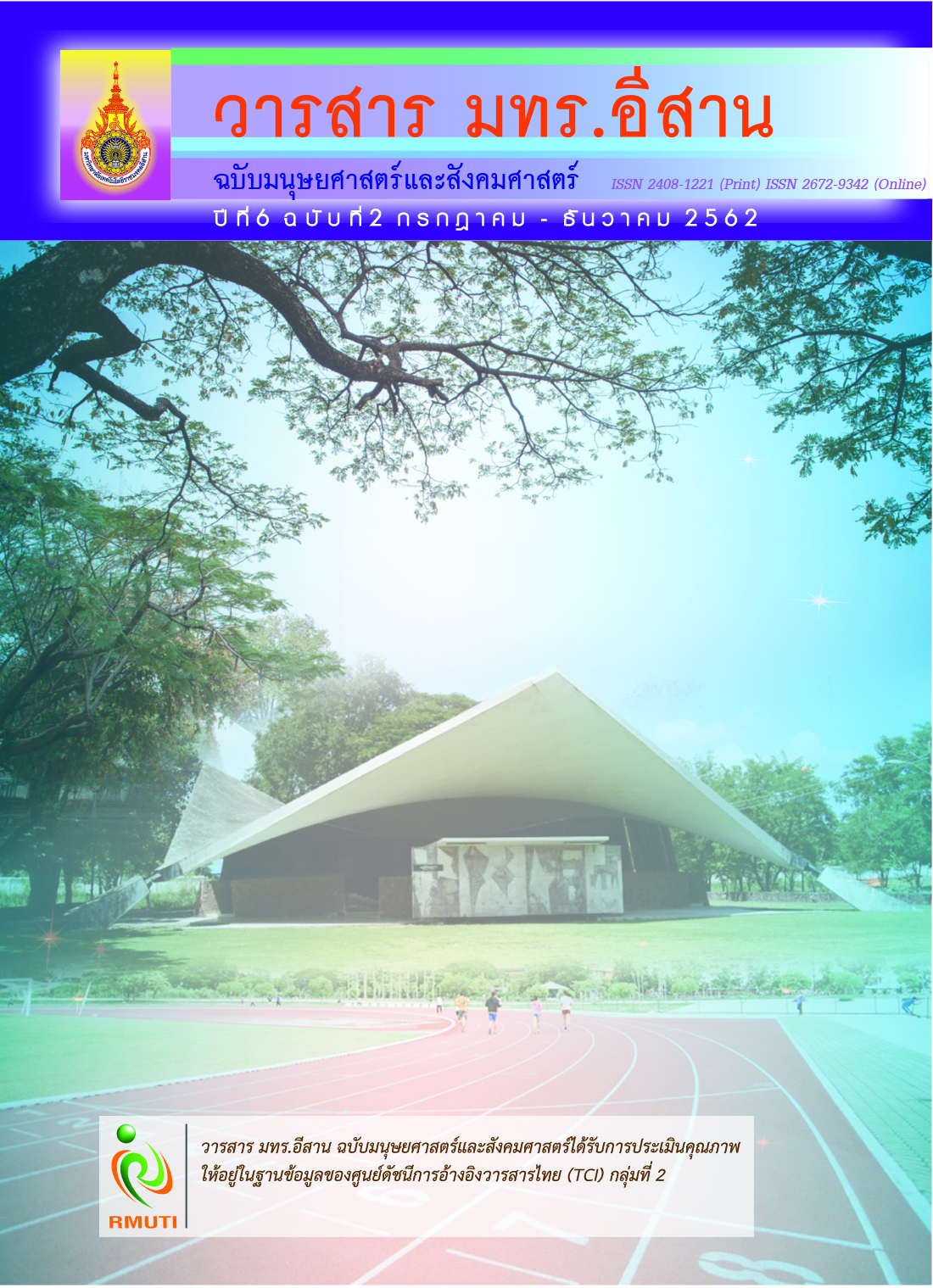M I N D Innovation: Effect of Teaching and Learning Style Toward Students’ Aptitude in English Context
Main Article Content
Abstract
The English language has presently become a very important global language because it is widely used as a means of international communication for all kinds of activities. Additionally, Thailand will become a member of the ASEAN Community and this will cause the English language to play a more vital role. Thai students spend twelve years studying English, but they cannot communicate in English. This paper aims at presenting a tool “MIND innovation” to help learners destroy barriers inside each psychology, set up self-learning forever with lifelong learning & sharing with others. Focusing on how to build up learners’ psychological, how to use appropriate teaching and learning style, how to adapt the self-learning approach, and how to teach students to contribute their knowledge to others. This paper identifies various distinguishing features of approaches towards 4 factors; motivation, intention, neo- understanding, and demonstrates with regard to scope follow lifelong learning. All of them should we take as a sample to get the better teaching and learning English. Both teachers and students should more aware of how they cope with communication in order to get the high level of education.
Article Details
บทความที่ได้รับการตีพิมพ์เป็นลิขสิทธิ์ของมหาวิทยาลัยเทคโนโลยีราชมงคลอีสาน
ข้อความที่ปรากฏในบทความแต่ละเรื่องในวารสารวิชาการเล่มนี้เป็นความคิดเห็นส่วนตัวของผู้เขียนแต่ละท่านไม่เกี่ยวข้องกับมหาวิทยาลัยเทคโนโลยีราชมงคลอีสานและคณาจารย์ท่านอื่นๆในมหาวิทยาลัยฯ แต่อย่างใด ความรับผิดชอบองค์ประกอบทั้งหมดของบทความแต่ละเรื่องเป็นของผู้เขียนแต่ละท่าน หากมีความผิดพลาดใดๆ ผู้เขียนแต่ละท่านจะรับผิดชอบบทความของตนเองแต่ผู้เดียว
References
Bandura, A. (1977). Self-Efficacy: Toward a Unifying Theory of Behavioral Change. Psychological Review. Vol. 84, Issue 2, pp. 191-215. DOI: 10.1037/0033-295X.84.2.191
Dan, P. (2019). 20 Psychological Principles That Will Help Your Students Learn More Effectively. American Psychological Association. Access (23August 2019). Available (http://psychlearningcurve.org/these-psychological-principles-will-help-your-studentslearn-more-effectively/)
Fatt, J. P. (2000). Understanding the Learning Styles of Students. International Journal of Sociology and Social Policy. Vol. 20, No. 11-12, pp. 31-45. DOI: 10.1108/01443330010789269)
Haynes, J. (2009). Teach to Students’ Learning Styles. Access (11 August 2018). Available (http://www.everythingesl.net/inservices/learningstyle.php)
Juhana. (2012). Psychological Factors That Hinder Students from Speaking in English Class (A Case Study in a Senior High School in South Tangerang, Banten, Indonesia). Journal of Education and Practice. Vol. 3, No. 12, pp. 100-110
Khamkhien, A. (2010). Teaching English Speaking and English Speaking Tests in the Thai Context: A Refl ection from Thai Perspective. English Language Teaching. Vol. 3, No. 1, pp. 184-190
Kim, R., Olfman, L., Ryan, T., and Eryilmaz, E. (2014). Leveraging a Personalized System to Improve Self-Directed Learning in Online Educational Environments. Computers & Education. Vol. 70, pp. 150-160. DOI: 10.1016/j.compedu.2013.08.006
Knowles, M. S. (1986). Using Learning Contracts: Practical Approaches to Individualizing and Structuring Learning. London: Jossey-Bass Publications.
Kirkpatrick, A. (2012). Teaching English as a Lingua Franca in ASEAN: Maintaining Linguistic and Cultural Diversity. Proceeding of the 2012 International Conference on Cultural and Linguistic Diversity in ASSEAN. Suan Dusit Rajabhat Unversity, Bangkok, Thailand, pp. 17-25
Kongkerd, W. (2013). Teaching English in the Era of English used as a Lingua Franca in Thailand. Executive Journal. Vol. 33, No. 4, pp. 3-12
Little, D. (2005). The Common European Framework and the European Language Portfolio: Involving Learners and Their Judgments in the Assessment Process. Language Testing. Vol. 22, Issue 3, pp. 321-336. DOI: 10.1191/0265532205lt311oa
Littlewood, W. (1996). “Autonomy” : an Anatomy and a Framework System. System. Vol. 24, Issue 4, pp. 427- 435. DOI: 10.1016/S0346-251X(96)00039-5
Lyman, F. (1987). Think-Pair-Share: An Expanding Teaching Technique: MAA-CIE. Cooperative News
Manochehri, N. and Young, J. I. (2006). The Impact of Student Learning Styles with Web-Based Learning or Instructor-Based Learning on Student Knowledge and Satisfaction. Quarterly Review of Distance Education. Vol. 7, Number 3, pp. 313-316
Naimie, Z., Siraj, S., Abuzaid, R. A., and Shagoholi, R. (2010). Hypothesized Learners’ Technology Preferences Based on Learning Style Dimensions. Turkish Online Journal of Educational Technology. Vol. 9, Issue 4, pp. 83-93
Tuong, H. N. (n.d). Thailand: Culture Background for ESL/EFL Teachers. Access on (1 August 2018). Available (http://hmongstudies.org/ThaiCulture.pdf).
Raya, M., Lamb, T., and Vieira, F. (2007). Pedagogy for Autonomy in Language Education in Europe: Towards a Framework for Learner and Teacher Development. Dublin: Authentik
Reeve, R. A. and Pattison, P. E. (1996). The Referential Adequacy of Students’ Visual Analogies of Fractions. Mathematical Cognition. Vol. 2, Issue 2, pp. 137-169. DOI: 10.1080/135467996387507
Richards, J. C. and Renandya, W. A. (2002). Methodology in Language Teaching: An Anthology of Current Practice. New York: Cambridge University Press
Southwestern Community College of North Carolina. (2016). The VAK Learning System. Access (14 August 2018). Available (http://www.southwesterncc.edu/sites/default/fi les/VAK_Learning_Styles.pdf)
Stevick, E. W. (1976). Memory Meaning & Method. Massachusetts: Newbury House
Yang, N. -D. (1998). Exploring a New Role for Teachers: Promoting Learner Autonomy. System, 26/1998. pp. 127-135
Wentzel, K. (1998). Social Relationships and Motivation in Middle School : The Role of Parents, Teachers, and Peers. Journal of Educational Psychology. Vol. 90, Issue 2, pp. 202-209. DOI: 10.1037/0022-0663.90.2.202
Wiriyachitra, A. (2002). English Language Teaching and Learning in Thailand in this Decade. Thai TESOL Focus. Vol. 15, No. 1, pp. 4-9


